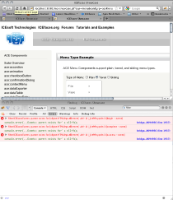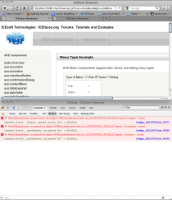Details
-
Type:
 Bug
Bug
-
Status: Closed
-
Priority:
 Major
Major
-
Resolution: Fixed
-
Affects Version/s: 3.0.RC1
-
Component/s: Sample Apps
-
Labels:None
-
Environment:ICEfaces 3, showcase sample app., MyFaces 2.1.3
-
Assignee Priority:P1
Description
Using the showcase sample with MyFaces 2.1.3, several demos that use the h:selectOneRadio component can fail with errors:
ace:menubar:
Effects:
Internet Explorer / Firefox: When changing 'Transition Effect' multiple times the radio button becomes unselected and a validation error is seen.
Haven't seen this myself and couldn't reproduce exactly as described. There were some intermittent client side errors in the console but not on every click:
[window] configuration not found for INPUT
[window] configuration not found for INPUT
[window] Error [status: clientError code: undefined]: undefined
exception ? console.er...ror(formatOutput(category, message));
'cannot find enclosing form' when calling method: [nsIDOMEventListener::handleEvent]
[Break On This Error] originalHandler.handleEvent(event);
----------------------------------------------------------
ace:menu:
Type:
Internet Explorer / Firefox: When changing 'Type of Menu' multiple times the radio button becomes unselected and a validation error is seen.
Haven't seen this myself and couldn't reproduce exactly as described. There were some intermittent client side errors in the console but not on every click:
[window] configuration not found for INPUT
[window] configuration not found for INPUT
[window] Error [status: clientError code: undefined]: undefined
exception ? console.er...ror(formatOutput(category, message));
'cannot find enclosing form' when calling method: [nsIDOMEventListener::handleEvent]
[Break On This Error] originalHandler.handleEvent(event);
----------------------------------------------------
ace:menubar:
Effects:
Internet Explorer / Firefox: When changing 'Transition Effect' multiple times the radio button becomes unselected and a validation error is seen.
Haven't seen this myself and couldn't reproduce exactly as described. There were some intermittent client side errors in the console but not on every click:
[window] configuration not found for INPUT
[window] configuration not found for INPUT
[window] Error [status: clientError code: undefined]: undefined
exception ? console.er...ror(formatOutput(category, message));
'cannot find enclosing form' when calling method: [nsIDOMEventListener::handleEvent]
[Break On This Error] originalHandler.handleEvent(event);
ace:menubar:
Effects:
Internet Explorer / Firefox: When changing 'Transition Effect' multiple times the radio button becomes unselected and a validation error is seen.
Haven't seen this myself and couldn't reproduce exactly as described. There were some intermittent client side errors in the console but not on every click:
[window] configuration not found for INPUT
[window] configuration not found for INPUT
[window] Error [status: clientError code: undefined]: undefined
exception ? console.er...ror(formatOutput(category, message));
'cannot find enclosing form' when calling method: [nsIDOMEventListener::handleEvent]
[Break On This Error] originalHandler.handleEvent(event);
----------------------------------------------------------
ace:menu:
Type:
Internet Explorer / Firefox: When changing 'Type of Menu' multiple times the radio button becomes unselected and a validation error is seen.
Haven't seen this myself and couldn't reproduce exactly as described. There were some intermittent client side errors in the console but not on every click:
[window] configuration not found for INPUT
[window] configuration not found for INPUT
[window] Error [status: clientError code: undefined]: undefined
exception ? console.er...ror(formatOutput(category, message));
'cannot find enclosing form' when calling method: [nsIDOMEventListener::handleEvent]
[Break On This Error] originalHandler.handleEvent(event);
----------------------------------------------------
ace:menubar:
Effects:
Internet Explorer / Firefox: When changing 'Transition Effect' multiple times the radio button becomes unselected and a validation error is seen.
Haven't seen this myself and couldn't reproduce exactly as described. There were some intermittent client side errors in the console but not on every click:
[window] configuration not found for INPUT
[window] configuration not found for INPUT
[window] Error [status: clientError code: undefined]: undefined
exception ? console.er...ror(formatOutput(category, message));
'cannot find enclosing form' when calling method: [nsIDOMEventListener::handleEvent]
[Break On This Error] originalHandler.handleEvent(event);


This one is a bit trickier to reproduce. The most reliable method is to use the ace:menubar example, chose the "Type" demo and then click between the radio buttons quickly. It requires that you run with MyFaces and Firefox (or IE). I did not see problems using Mojarra or WebKit browsers.
With Firefox, using the Firebug JS Debugger, I was able to capture the following:
serverErrorMessage
"MyFaces ERROR:Affected Class:myfaces._impl.xhrCore._AjaxRequest Affected Method:send Error Name:undefined Error Name:undefined Error Description:undefined Error Number:undefined Error Line Number:undefined "
serverErrorName
"UNKNOWN"
source
input#j_id1290760492_491dd227:typeIn:2 sliding
status
"clientError"
type
"error"